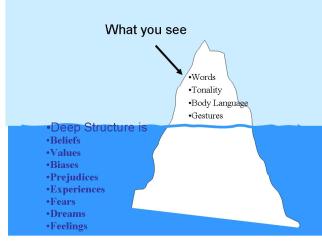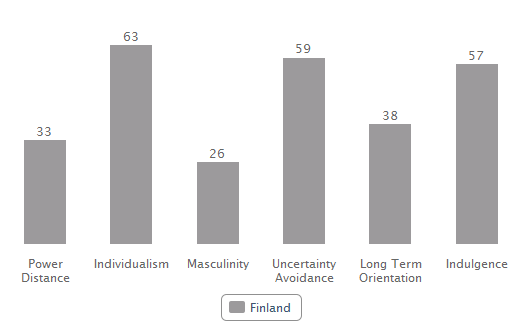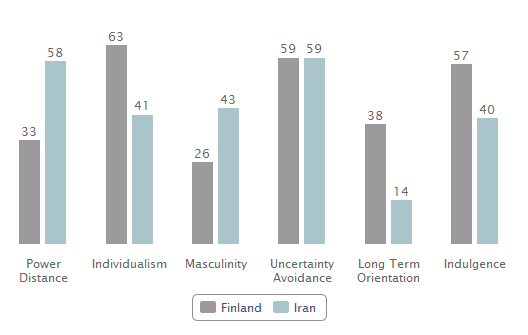Geert Hofstede
Gerard Hendrik (Geert) Hofstede (born 2 October 1928) is a Dutch social psy chologist, former IBM employee, and Professor Emeritus of Organizational Anthropology and International Management at Maastricht University in the Netherlands, well known for his pioneering research on cross-cultural groups and organizations. His most notable work has been in developing cultural dimensions theory. Hofstede’s model explaining national cultural differences and their consequences, when introduced in 1980, came at a time when cultural differences between societies had become increasingly relevant for both economic and political reasons. Here he describes national cultures along six dimensions.
chologist, former IBM employee, and Professor Emeritus of Organizational Anthropology and International Management at Maastricht University in the Netherlands, well known for his pioneering research on cross-cultural groups and organizations. His most notable work has been in developing cultural dimensions theory. Hofstede’s model explaining national cultural differences and their consequences, when introduced in 1980, came at a time when cultural differences between societies had become increasingly relevant for both economic and political reasons. Here he describes national cultures along six dimensions.
6D cultural model

- Power distance: This dimension deals with the fact that all individuals in societies are not equal. It expresses the attitude of the culture towards these inequalities amongst us. Power Distance is defined as the extent to which the less powerful members of institutions and organisations within a country expect and accept that power is distributed unequally.
- Individualism: The fundamental issue addressed by this dimension is the degree of interdependence a society maintains among its members. It has to do with whether people´s self-image is defined in terms of “I” or “We”. In Individualist societies people are supposed to look after themselves and their direct family only. In Collectivist societies people belong to ‘in groups’ that take care of them in exchange for loyalty.
- Masculinity: A high score (Masculine) on this dimension indicates that the society will be driven by competition, achievement and success, with success being defined by the winner/best in field – a value system that starts in school and continues throughout organisational life. A low score (Feminine) on the dimension means that the dominant values in society are caring for others and quality of life. A Feminine society is one where quality of life is the sign of success and standing out from the crowd is not admirable. The fundamental issue here is what motivates people, wanting to be the best (Masculine) or liking what you do (Feminine).
- Uncertainty avoidance: The dimension Uncertainty Avoidance has to do with the way that a society deals with the fact that the future can never be known: should we try to control the future or just let it happen? This ambiguity brings with it anxiety and different cultures have learnt to deal with this anxiety in different ways. The extent to which the members of a culture feel threatened by ambiguous or unknown situations and have created beliefs and institutions that try to avoid these is reflected in the score on Uncertainty Avoidance.
- Long term orientation: This dimension describes how every society has to maintain some links with its own past while dealing with the challenges of the present and future, and societies prioritise these two existential goals differently. Normative societies, which score low on this dimension, for example, prefer to maintain time-honoured traditions and norms while viewing societal change with suspicion. Those with a culture which scores high, on the other hand, take a more pragmatic approach: they encourage thrift and efforts in modern education as a way to prepare for the future.
- Indulgence: One challenge that confronts humanity, now and in the past, is the degree to which small children are socialized. Without socialization we do not become “human”. This dimension is defined as the extent to which people try to control their desires and impulses, based on the way they were raised. Relatively weak control is called “Indulgence” and relatively strong control is called “Restraint”. Cultures can, therefore, be described as Indulgent or Restrained.
Finland in Geert’s cultural model
Low power distance means that the following characterises the Finnish style: Being independent, hierarchy for convenience only, equal rights, superiors accessible, coaching leader, management facilitates and empowers. Power is decentralized and managers count on the experience of their team members. Employees expect to be consulted. Control is disliked and attitude towards managers are informal and on first name basis. Communication is direct and participative.
Individualist society means there is a high preference for a loosely-knit social framework in which individuals are expected to take care of themselves and their immediate families only. In Individualist societies offence causes guilt and a loss of self-esteem, the employer/employee relationship is a contract based on mutual advantage, hiring and promotion decisions are supposed to be based on merit only, management is the management of individuals.
Feminine society in which, the focus is on “working in order to live”, managers strive for consensus, people value equality, solidarity and quality in their working lives. Conflicts are resolved by compromise and negotiation. Incentives such as free time and flexibility are favoured. Focus is on well-being, status is not shown. An effective manager is a supportive one, and decision making is achieved through involvement.
High Uncertainty Avoidance society maintains rigid codes of belief and behaviour. In these cultures there is an emotional need for rules (even if the rules never seem to work), time is money, people have an inner urge to be busy and work hard, precision and punctuality are the norm, innovation may be resisted and security is an important element in individual motivation.
Normative society in which, People have a strong concern with establishing the absolute Truth; they are normative in their thinking. They exhibit great respect for traditions, a relatively small propensity to save for the future, and a focus on achieving quick results.
Indulgent country in which, People generally exhibit a willingness to realise their impulses and desires with regard to enjoying life and having fun. They possess a positive attitude and have a tendency towards optimism. In addition, they place a higher degree of importance on leisure time, act as they please and spend money as they wish.
Finland VS Iran in Geert’s cultural model

Iran (my home country) has
- Hierarchical society means that people accept a hierarchical order in which everybody has a place and which needs no further justification. Hierarchy in an organisation is seen as reflecting inherent inequalities, centralisation is popular, subordinates expect to be told what to do and the ideal boss is a benevolent autocrat.
- Collectivistic society fosters strong relationships where everyone takes responsibility for fellow members of their group. Loyalty is paramount, and over-rides most other societal rules and regulations. Offence leads to shame and loss of face, employer/employee relationships are perceived in moral terms (like a family link), hiring and promotion decisions take account of the employee’s in-group, management is the management of groups.
- Feminine society (like Finland)
- High uncertainty Avoidance society (like Finland)
- Normative society (like Finland)
- Restraint society have a tendency to cynicism and pessimism. Also, in contrast to Indulgent societies, restrained societies do not put much emphasis on leisure time and control the gratification of their desires. People with this orientation have the perception that their actions are restrained by social norms and feel that indulging themselves is somewhat wrong.
Hofstede’s model in education systems
The cultural model found by Geert Hofstede provide an analytical tool for understanding the local differences in the educational policy and school systems.
|
Power distance |
|
|
Low |
High |
| Student centered. Premium on initiative | Teacher centered. Premium on order |
| Teacher expects student to initiate communication | Student expects teacher to initiate communication |
| Teacher expects students to find own paths | Student expects teacher to outline paths |
| Students allowed to contradict & criticize | Teacher never contradicted nor criticized |
| Effectiveness of learning is a function the amount of two-way communication | Effectiveness of learning is a function of the
excellence of teachers |
|
Implications of collectivism VS. Individualism on teaching |
|
|
Collectivist |
Individualist |
| Students only speak
up when called on by the teacher |
Students speak up in response to general invitation by the teacher |
| Individuals only speak up in small groups | Individuals will speak up in large groups |
| Formal harmony in learning situations should be maintained at all times | Confrontation and challenge in learning situations can be brought into the open |
| Neither teacher nor student should ever be made to lose face | “face consciousness” is weak |
| Teachers expected to give preferential treatment to some, e.g. based on ethnic affiliation or recommendation | Teachers expected to be strictly impartial |
|
Implications of femininity VS. masculinity on teaching |
|
|
Feminine |
Masculine |
| Teachers use average students as norm | Teachers use best students as norm |
| System rewards students’ social adaptation | System rewards academic performance |
| Student’s failure at school a relatively minor accident | Student’s failure in school a severe blow to student self image
|
| students try to behave modestly | students try to make themselves visible |
| Students choose subjects out of interest | Students choose subjects for career reasons |
|
Implications of Uncertainty Avoidance on teaching |
|
|
Low |
High |
| Students comfortable in Unstructured learning situations:
× Broad assignments × No timetables |
Students comfortable in structured learning situations:
× Precise instructions × Detailed assignments × Strict timetables |
| Teachers allow to say “I don’t know” | Teachers expected to have all the answers |
| Good teachers use plain language | Good teachers use academic language |
| Students rewarded for innovative approaches | Students rewarded for accuracy |
| Teachers view intellectual disagreement as stimulating | Teachers view intellectual disagreement as personal disloyalty |
|
Implications of Long term orientation on teaching |
|
|
Low |
High |
| Focus on asking “why”? | Focus on asking “How”? |
| Students want to find the one and only solution | Different answers possible. “Many Truth” |
| Strong emphasis on education as obligation to parents and society | |
| Stability rated as the most important virtue | Perseverance rated as the most important virtue |
The quality of teachers is related to how country cultures are defining the role of teachers in the education process. It is a matter of effectiveness to accept this and to understand that results can be obtained in different ways. Look at the differences between the first two countries in the ranking system Finland and South Korea:

|
Finland |
South Korea |
| Student centered education
|
Teacher centered education |
| Effectiveness of learning related to amount of two-way communication
|
Effectiveness of learning related to excellence of teacher |
| Teacher expects students take initiative | Students expect initiative from
teacher |
| Teacher expects students find their own path | Students expect teacher to outline paths |
| A good teacher uses plain language | A good teacher uses academic language |
| Teachers interpret intellectual disagreement as stimulating | Teachers interpret intellectual disagreement as personal disloyalty
|
| Face consciousness weak | Neither teacher nor student should ever be made to lose face |

